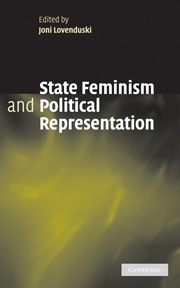Book contents
- Frontmatter
- Contents
- List of figures
- List of tables
- Notes on contributors
- Preface
- List of abbreviations
- 1 Introduction: state feminism and the political representation of women
- 2 Gendering political representation: debates and controversies in Austria
- 3 The Belgian paradox: inclusion and exclusion of gender issues
- 4 A politics for presence: state feminism, women's movements and political representation in Finland
- 5 Gendering the republican system: debates on women's political representation in France
- 6 WPAs and political representation in Germany
- 7 Gendering the debate on political representation in Italy: a difficult challenge
- 8 High tides in a low country: gendering political representation in the Netherlands
- 9 The women's movement, gender equality agencies and central-state debates on political representation in Spain
- 10 Party feminism, state feminism and women's representation in Sweden
- 11 Party government and women's representation debates: the UK
- 12 Women's policy agencies, the women's movement and representation in the USA
- 13 Conclusions: state feminism and political representation
- Appendix 1 Tables of women's representation in eleven countries
- Appendix 2 The RNGS model: summary of variable descriptors
- Index
- References
7 - Gendering the debate on political representation in Italy: a difficult challenge
Published online by Cambridge University Press: 22 September 2009
- Frontmatter
- Contents
- List of figures
- List of tables
- Notes on contributors
- Preface
- List of abbreviations
- 1 Introduction: state feminism and the political representation of women
- 2 Gendering political representation: debates and controversies in Austria
- 3 The Belgian paradox: inclusion and exclusion of gender issues
- 4 A politics for presence: state feminism, women's movements and political representation in Finland
- 5 Gendering the republican system: debates on women's political representation in France
- 6 WPAs and political representation in Germany
- 7 Gendering the debate on political representation in Italy: a difficult challenge
- 8 High tides in a low country: gendering political representation in the Netherlands
- 9 The women's movement, gender equality agencies and central-state debates on political representation in Spain
- 10 Party feminism, state feminism and women's representation in Sweden
- 11 Party government and women's representation debates: the UK
- 12 Women's policy agencies, the women's movement and representation in the USA
- 13 Conclusions: state feminism and political representation
- Appendix 1 Tables of women's representation in eleven countries
- Appendix 2 The RNGS model: summary of variable descriptors
- Index
- References
Summary
Introduction
In Italy, the concept of democracy has long been thought of as a means to represent social and political divisions. The need to guarantee access to decision-making arenas for the greatest number of social demands explains why, after the Second World War, a proportional-type electoral system with no minimum threshold was adopted. The results were a multi-party system and coalition governments (Verzichelli and Cotta 2003). Until the 1990s there was no alternation of government coalitions, but merely changes in coalition partners of the dominant Christian Democrats. After the late 1970s widespread discontent about the unstable and inefficient government coalitions increased and a debate about constitutional reforms developed.
By the early 1990s, discontent had become crisis. The legitimacy of the political elite collapsed leading to a widespread call for its replacement. Party identities dissolved and organisations disintegrated, making way for the rapid emergence of new political forces. The crisis accelerated the adoption of new institutional rules. Although there were many contributing factors (Cotta and Isernia 1996; Ginsborg 1996; Pasquino 2002), the determining event was the Mani pulite (Clean Hands) investigation launched by the judiciary in 1992. Mani pulite brought to light a widespread pattern of corruption involving the highest levels of the Italian political elite. It led to the dismantling of the party system. It focused on the government parties and, in particular, on their leaders.
- Type
- Chapter
- Information
- State Feminism and Political Representation , pp. 130 - 152Publisher: Cambridge University PressPrint publication year: 2005
References
- 16
- Cited by



